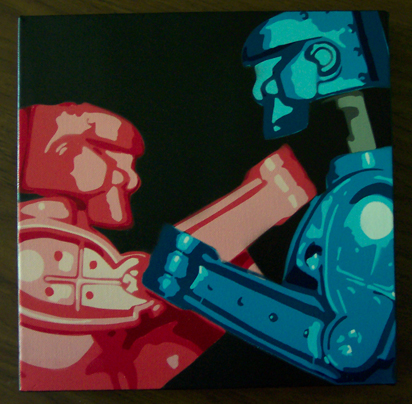Transcending Our Financial Accounting Systems
 In business and in life, one of the biggest choices is what to do next. Sounds simple, but it’s not.
In business and in life, one of the biggest choices is what to do next. Sounds simple, but it’s not.
The decision has many facets and drives many questions, for example: Does it fit with core competence? Does it fit with the brand? How many will we sell? What will the market look like after it’s launched? Do we have what it takes to pull it off?
These questions then explode into a series of complex financial analyses like – return on investment, return on capital, return on net assets (and all its flavors) and all sorts of yet-to-be created return on this’s and that’s. This return business is all about the golden ratio – how much will we make relative to how much it costs. All the calculations, regardless of their name, are variations on this theme. And all suffer the same fundamental flaw – they are based on an artificial system of financial accounting.
To me, especially when working in new territory, we must transcend the self-made biases and limitations of GAAP and ask the bedrock question – Is it worth it?
In the house of cards of our financial accounting, worth equals dollars. Nothing more, nothing less. And this simplistic, formulaic characterization has devastating consequence. Worth is broader than profit, it’s nuanced, it’s philosophical, it’s about people, it’s about planet. Yet we let our accounting systems lead us around by the nose as if people don’t matter, like the planet doesn’t matter, like what we stand for doesn’t matter. Simply put, worth is not dollars.
The single-most troubling artifact of our accounting systems is its unnatural bias toward immediacy. How much will we make next year? How about next quarter? What will we spend next month? If we push out the expense by a month how much will we save? What will it do to this quarter’s stock price? It’s like the work has no validity unless the return on investment isn’t measured in days, weeks or months. It seems the only work that makes it through the financial analysis gauntlet is work that costs nothing and returns almost nothing. Under the thumb of financial accounting, projects are small in scope, smaller in resource demands and predictable in time. This is a recipe for minimalist improvement and incrementalism.
What about the people doing the work? Why aren’t we concerned they can’t pay their mortgages? Why do we think it’s okay to demand they work weekends? Why don’t we hold their insurance co-pays at reasonable levels? Why do we think it’s okay to slash our investment in their development? What about their self-worth? Just because we can’t measure it in a financial sense, don’t we think it’s a liability to foster disenchantment and disengagement? If we considered our people an asset in a financial accounting sense, wouldn’t we invest in them to protect their output? Why do we preventive maintenance on our machines but not our people?
When doing innovative work, our financial accounting systems fail us. These systems were designed in an era when it was best to increase the maturity of immature systems. But now that our systems are mature, and our objective is to obsolete them, our ancient financial accounting systems hinder more than help. The domains of reinvention and disruption are dominated by judgement, not rigid accounting rules. Innovation is the domain of incomplete data and uncertain outcomes and not the domain of debits and credits.
Profit is important, but profit is a result. Financial accounting doesn’t create profit, people create profit. And the currency of people are thoughts, feelings and judgement.
With innovation, it’s better to create the conditions so people believe in the project and are fully engaged in their work. With creativity, it’s better to have empowered people who will move mountains to do what must be done. With work that’s new, it’s better to trust people and empower them to use their best judgement.
Image credit – Jeremy Tarling
Imagination
 If you can’t imagine it, it can’t be done.
If you can’t imagine it, it can’t be done.
But if it can’t be done, how can you imagine it?
No one is buying a product like the one you imagined. There’s no market.
No one can buy an imaginative product that doesn’t yet exist. There may be a market.
Imagine things are good, just as they are.
Imagine an upstart competitor will obsolete your best product.
Let’s fix what is.
Let’s imagine what isn’t, and build it.
Don’t waste time imagining radical new concepts. There’s no way to get there.
Use your imagination to create an unobtainable concept, then build a bridge to get there.
Imagine the future profits of our great recipe. Let’s replicate it.
Imagine our recipe has a half-life. Let’s disrupt it.
To be competitive, we’ve got to use our imagination to reduce the cost of our products.
To be competitive, we’ve got to use our imagination to obsolete our best work.
Put together a specification, a detailed Gannt chart and make it happen on time.
Imagine what could be, and make a prototype.
Let’s shore up our weaknesses and live to fight another day.
Let’s imagine our strength as a weakness and invent the future.
We are the best in the industry. Imagine how tough it is to be our competitor.
Imagine there’s a hungry start-up who will do whatever it takes to get the business.
We’ve got to protect our market share.
Imagine what we could create if we weren’t constrained by our success.
Imagine how productive we will be when we standardize the work.
Imagine how much fun we will have when we reinvent the industry.
Ask the customer what they want, built it and launch it.
Imagine what could be, build a prototype, show the customer, listen and refine.
Let’s follow the script. Imagine the profits.
Let’s burn the script and imagine a new one.
Image credit — Allegra Ricci
With innovation you’ve got to feel worthy of the work.
 When doing work that’s new, sometimes it seems the whole world is working against you. And, most of the time, it is. The outside world is impossible to control, so the only way to deal with external resistance is to pretend you don’t hear it. Shut your ears, put your head down and pull with all your might. Define your dream and live it. And don’t look back. But what about internal resistance?
When doing work that’s new, sometimes it seems the whole world is working against you. And, most of the time, it is. The outside world is impossible to control, so the only way to deal with external resistance is to pretend you don’t hear it. Shut your ears, put your head down and pull with all your might. Define your dream and live it. And don’t look back. But what about internal resistance?
Where external resistance cannot be controlled and must be ignored, internal resistance, resistance created by you, can be actively managed. The best way to deal with internal resistance is to prevent its manufacture, but very few can do that. The second best way is to acknowledge resistance is self-made and acknowledge it will always be part of the innovation equation. Then, understand the traps that cause us to create self-inflicted resistance and learn how to work through them.
The first trap prevents starting. At the initial stage of a project, two unstated questions power the resistance – What if it doesn’t work? and What if it does work? If it doesn’t work, the fear is you’ll be judged as incompetent or crazy. The only thing to battle this fear is self-worth. If you feel worthy of the work, you’ll push through the resistance and start. If it does work, the fear is you won’t know how to navigate success. Again, if you think you’re worthy of the work (the work that comes with success), you and your self-esteem will power through the resistance and start.
Underpinning both questions is a fundamental of new work that is misunderstood – new work is different than standard work. Where standard work follows a well-worn walking path, new work slashes through an uncharted jungle where there are no maps and no GPS. With standard work, all the questions have been answered, the scope is well established and the sequence of events and timeline are dialed in. With standard work, everything is known up front. With new work, it’s the opposite. Never mind the answers, the questions are unknown. The scope is uncertain and the sequence of events is yet to be defined. And the timeline cannot be estimated.
But with so much standard work and so little new work, companies expect people to that do the highly creative work to have all the answers up front. And to break through the self-generated resistance, people doing new work must let go of self-imposed expectations that they must have all the answers before starting. With innovation, the only thing that can be known is how to figure out what’s next. Here’s a generic project plan for new work – do the first thing and then, based on the results, figure out what to do next, and repeat.
To break through the trap that prevents starting, don’t hold yourself accountable to know everything at the start. Instead, be accountable for figuring out what’s next.
The second trap prevents progress. And, like the first trap, resistance-based paralysis sets in because we expect ourselves to have an etched-in-stone project plan and expect we’ll have all the answers up front. And again, there’s no way to have the right answers when the first bit of work must be done to determine the right questions. If you think you’re worthy of the work, you’ll be able to push through the resistance with the figure out what’s next approach.
When in the middle of an innovation project, hold yourself accountable to figuring out what to do next. Nothing more, nothing less. When the standard work police demand a sequence of events and a timeline, don’t buckle. Tell them you will finish the current task then define the next one and you won’t stop until you’re done. And if they persist, tell them to create their own project plan and do the innovation work themselves.
With innovation, it depends. With innovation, hold onto your self-worth. With innovation, figure out what’s next.
Image credit — Jonathan Kos-Read
Diabolically Simple Prototypes
 Ideas are all talk and no action. Ideas are untested concepts that have yet to rise to the level of practicality. You can’t sell an idea and you can’t barter with them. Ideas aren’t worth much.
Ideas are all talk and no action. Ideas are untested concepts that have yet to rise to the level of practicality. You can’t sell an idea and you can’t barter with them. Ideas aren’t worth much.
A prototype is a physical manifestation of an idea. Where ideas are ethereal, prototypes are practical. Where ideas are fuzzy and subject to interpretation, prototypes are a sledge hammer right between the eyes. There is no arguing with a prototype. It does what it does and that’s the end of that. You don’t have to like what a prototype stands for, but you can’t dismiss it. Where ideas aren’t worth a damn, prototypes are wholly worth every ounce of effort to create them.
If Camp A says it will work and Camp B says it won’t, a prototype will settle the disagreement pretty quickly. It will work or it won’t. And if it works, the idea behind it is valid. And if it doesn’t, the idea may be valid, but a workable solution is yet-to-be discovered. Either way, a prototype brings clarity.
Prototypes are not elegant. Prototypes are ugly. The best ones do one thing – demonstrate the novel idea that underpins them. The good ones are simple, and the best ones are diabolically simple. It is difficult to make diabolically simple prototypes (DSPs), but it’s a skill that can be learned. And it’s worth learning because DSPs come to life in record time. The approach with DSPs is to take the time up front to distill the concept down to its essence and then its all-hands-on-deck until it’s up and running in the lab.
But the real power of the DSP is that it drives rapid learning. When a new idea comes, it’s only a partially formed. The process of trying to make a DSP demands the holes are filled and blurry parts are brought into focus. The DSP process demands a half-baked idea matures into fully-baked physical embodiment. And it’s full-body learning. Your hands learn, your eyes learn and your torso learns.
If you find yourself in a disagreement of ideas, stop talking and start making a prototype. If the DSP works, the disagreement is over.
Diabolically simple prototypes end arguments. But, more importantly, they radically increase the pace of learning.
Image credit – snippets101
With innovation, it depends.
 By definition, when the work is new there is uncertainty. And uncertainty can be stressful. But, instead of getting yourself all bound up, accept it. More than that, relish in it. Wear it as a badge of honor. Not everyone gets the chance to work on something new – only the best do. And, because you’ve been asked to do work with a strong tenor of uncertainty, someone thinks you’re the best.
By definition, when the work is new there is uncertainty. And uncertainty can be stressful. But, instead of getting yourself all bound up, accept it. More than that, relish in it. Wear it as a badge of honor. Not everyone gets the chance to work on something new – only the best do. And, because you’ve been asked to do work with a strong tenor of uncertainty, someone thinks you’re the best.
But uncertainty is an unknown quantity, and our systems have been designed to reject it, not swim in it. When companies want to get serious they drive toward a culture of accountability and the new work gets the back seat. Accountability is mis-mapped to predictability, successful results and on time delivery. Accountability, as we’ve mapped it, is the mortal enemy of new work. When you’re working on a project with a strong element of uncertainty, the only certainty is the task you have in front of you. There’s no certainty on how the task will turn out, rather, there’s only the simple certainty of the task.
With work with low uncertainty there are three year plans, launch timelines and predictable sales figures. Task one is well-defined and there’s a linear flow of standard work right behind it – task two through twenty-two are dialed in. But when working with uncertainty, the task at hand is all there is. You don’t know the next task. When someone asks what’s next the only thing you can say is “it depends.” And that’s difficult in a culture of traditional accountability.
An “it depends” Gannt chart is an oxymoron, but with uncertainty step two is defined by step one. If A, then B. But if the wheels fall off, I’m not sure what we’ll do next. The only thing worse than an “it depends” Gantt chart is an “I’m not sure” Gannt chart. But with uncertainty, you can be sure you won’t be sure. With uncertainty, traditional project planning goes out the window, and “it depends” project planning is the only way.
With uncertainty, traditional project planning is replaced by a clear distillation of the problem that must be solved. Instead of a set of well-defined tasks, ask for a block diagram that defines the problem that must be solved. And when there’s clarity and agreement on the problem that must be solved, the supporting tasks can be well-defined. Step one – make a prototype like this and test it like that. Step two – it depends on how step one turns out. If it goes like this then we’ll do that. If it does that, we’ll do the other. And if it does neither, we’re not sure what we’ll do. You don’t have to like it, but that’s the way it is.
With uncertainty, the project plan isn’t the most important thing. What’s most important is relentless effort to define the system as it is. Here’s what the system is doing, here’s how we’d like it to behave and, based on our mechanism-based theory, here’s the prototype we’re going to build and here’s how we’re going to test it. What are we going to do next? It depends.
What’s next? It depends. What resources do you need? It depends. When will you be done? It depends.
Innovation is, by definition, work that is new. And, innovation, by definition, is uncertain. And that’s why with innovation, it depends. And that’s why innovation is difficult.
And that’s why you’ve got to choose wisely when you choose the people that do your innovation work.
Image credit – Sara Biljana Gaon (off)
The Causes and Conditions for Innovation
 Everyone wants to do more innovation. But how? To figure out what’s going on with their innovation programs, companies spend a lot of time to put projects into buckets but this generates nothing but arguments about whether projects are disruptive, radical innovation, discontinuous, or not. Such a waste of energy and such a source of conflict. Truth is, labels don’t matter. The only thing that matters is if the projects, as a collection, meet corporate growth objectives. Sure, there should be a short-medium-long look at the projects, but, for the three time horizons the question is the same – Do the projects meet the company’s growth objectives?
Everyone wants to do more innovation. But how? To figure out what’s going on with their innovation programs, companies spend a lot of time to put projects into buckets but this generates nothing but arguments about whether projects are disruptive, radical innovation, discontinuous, or not. Such a waste of energy and such a source of conflict. Truth is, labels don’t matter. The only thing that matters is if the projects, as a collection, meet corporate growth objectives. Sure, there should be a short-medium-long look at the projects, but, for the three time horizons the question is the same – Do the projects meet the company’s growth objectives?
To create the causes and conditions for innovation, start with a clear growth objective by geography. Innovation must be measured in dollars.
Good judgement is required to decide if a project is worthy of resources. The incremental sales estimates are easy to put together. The difficult parts are deciding if there’s enough sizzle to cause customers to buy and deciding if the company has the chops to do the work. The difficulty isn’t with the caliber of judgement, rather it’s insufficient information provided to the people that must use their good judgement. In shorth, there is poor clarity on what the projects are about. Any description of the projects blurry and done at a level of abstraction that’s too high. Good judgement can’t be used when the picture is snowy, nor can it be effective with a flyby made in the stratosphere.
To create the causes and conditions for innovation, demand clarity and bedrock-level understanding.
To guarantee clarity and depth, use the framework of novel, useful, successful. Give the teams a tight requirement for clarity and depth and demand they meet it. For each project, ask – What is the novelty? How is it useful? When the project is completed, how will everyone be successful?
A project must deliver novelty and the project leader must be able to define it on one page. The best way to do this is to create physical (functional) model of the state-of-the-art system and modify it with the newness created by the project (novelty called out in red). This model comes in the form of boxes that describe the system elements (simple nouns) and arrows that define the actions (simple verbs). Think hammer (box – simple noun) hits (arrow -simple verb) nail (box – simple noun) as the state-of-the-art system and the novelty in red – a thumb protector (box) that blocks (arrow) hammer (box). The project delivers a novel thumb protector that prevents a smashed thumb. The novelty delivered by the project is clear, but does it pass the usefulness test?
To create the causes and conditions for innovation, demand a one-page functional model that defines and distills down to bedrock level the novelty created by the project. And to help the project teams do it, hire a good teach teacher and give them the tools, time and training.
The novelty delivered by a project must be useful and the project leader must clearly define the usefulness on one page. The best way to do this is with a one page hand sketch showing the customer actively using the novelty. In a jobs-to-be-done way, the sketch must define where, when and how the customer will realize the usefulness. And to force distillation blinding, demand they use a fat, felt tip marker. With this clarity, leaders with good judgement can use their judgement effectively. Good questions flow freely. Does every user of a hammer need this? Can a left-handed customer use the thumb guard? How does it stay on? Doesn’t it get in the way? Where do they put it when they’re done? Do they wear it all the time? With this clarity, the questions are so good there is no escape. If there are holes they will be uncovered.
To create the causes and conditions for innovation, demand a one-page hand sketch of the customer demonstrating the useful novelty.
To be successful, the useful novelty must be sufficiently meaningful that customers pay money for it. The standard revenue projections are presented, but, because there is deep clarity on the novelty and usefulness, there is enough context for good judgement to be effective. What fraction of hammer users hit their thumbs? How often? Don’t they smash their fingers too? Why no finger protection? Because of the clarity, there is no escape.
To create the causes and conditions, use the deep clarity to push hard on buying decisions and revenue projections.
The novel, useful, successful framework is a straightforward way to decide if the project portfolio will meet growth objectives. It demands a clear understanding of the newness created by the project but, in return, provides context needed to use good judgement. In that way, because projects cannot start without passing the usefulness and successfulness tests, resources are not allocated to unworthy projects.
But while clarity and this level of depth is a good start, it’s not enough. It’s time for a deeper dive. The project must distill the novelty into a conflict diagram, another one-pager like the others, but deeper. Like problem definition on steroids, a conflict must be defined in space – between two things (thumb and face of hammer head) – and time (just as the hammer hits thumb). With that, leaders can ask before-during-after questions. Why not break the conflict before it happens by making a holding mechanism that keeps the thumb out of the strike zone? Are you sure you want to solve it during the conflict time (when the hammer hits thumb)? Why not solve it after the fact by selling ice packs for their swollen thumbs?
But, more on the conflict domain at another time.
For now, use novel, useful, successful to stop bad projects and start good ones.
Image credit – Natashi Jay
You can’t control much with innovation, but you can control how you allocate resources.
 In business, the only direct lever to pull is resource allocation. The people are already on the books, just change what they work on. But pulling that off is difficult.
In business, the only direct lever to pull is resource allocation. The people are already on the books, just change what they work on. But pulling that off is difficult.
No need to wait for new hires, just move resources from one project to another. Stop project A and start project B. Simple, right? Not so much. Emotional attachment causes project A to defend their resources and project B to complain the resources haven’t moved. Resources will be slow to flow.
No need to take the time to develop new capability, just reassign capable resources from business 1 to business 2 and watch progress unfold. No problem, right? Wrong. There’s immense organizational drama from prioritizing one business over another. Again, the pace of resource flow will be glacial.
And with innovation, the drama is doubled. It’s threatening when resources flow from mainstream projects with tangible (but small) returns to more speculative projects with highly uncertain returns. But that’s what must happen.
If there’s a mismatch between the words and resource allocation, believe resource allocation.
If the innovation banners are plastered on all the walls and everyone has the tee shirt, yet the resources don’t flow to the innovation work, it’s an innovation farce. Run away. Here’s what the four HOWs of innovation look like through the lens of resource allocation.
How To Start. Define the yearly funding level for innovation resources that is independent of the yearly planning process. In short, create an innovation tax at a fixed percentage of revenue. This gets funded before anything else. It’s the pay-yourself-first approach to innovation. And when the money is allocated and the resources flow, there’s no need for banners and tee shirts. Alignment comes with the money.
Next, choose a leader to put in place standing processes to continuously funnel project ideas into a common hopper. One pile for all ideas – university research, mergers and acquisitions, voice of the technology, voice of the customer (direct observation and listening), patents and YouTube videos of purposeful misuse of your product.
How To Choose. Define funding levels across the various flavors of projects in the portfolio and set up a standing meeting for senior leaders to choose the best projects. This selection process is light on analysis and heavy on judgment, so allocate leaders who are not afraid to use good judgement. And set up a standing meeting with the CEO to pace the selection work (make sure senior leaders allocate their time.)
How To Execute. Internal, external, or partner, the work defines the right way to allocate resources. Based on the work, choose the right organization and the best leader and fully staff the project before considering a second project. The most popular failure mode is running too many projects in parallel and getting none done. The second popular failure mode forgetting to fund the support resources needed for innovation. Allocate money for tools, time, training and a teacher. Establish a standing meeting where senior leaders review the projects. This must be outside the review process normal projects.
How To Improve. No one ever allocates time to do this. To get the work done, trick the system and include the work as a standing agenda item in the How To Execute review meetings. Find a problem, fix a problem. Improve as you go.
Allocate the best resources to the best projects and make sure senior leaders allocate time to the innovation work. The best predictors of successful innovation are the character of the fully-staffed, fully-funded projects and the character of people that run them.
Image credit – conorwithonen
Understanding the trajectory of the competitive landscape
 If you want to gain ground on your competition you’ve first got to know where things stand. Where are their advantages? Where are your advantages? Where is there parity? To quickly understand the situations there are three tricks: stay at a high level, represent the situation in a clear way and, where possible, use public information from their website.
If you want to gain ground on your competition you’ve first got to know where things stand. Where are their advantages? Where are your advantages? Where is there parity? To quickly understand the situations there are three tricks: stay at a high level, represent the situation in a clear way and, where possible, use public information from their website.
A side-by-side comparison of the two companies’ products is the way to start. Create a common set of axes with price running south to north and performance (or output) running west to east. Make two copies and position them side-by-side on the page – yours on the left and theirs directly opposite on the right. Go to their website (and yours) and make a list of every product, its price and its output. (For prices of their products you may have to engage your sales team and your customers.) For each of your products place a symbol (the company logo) on your performance-price landscape and do the same for their products on their landscape. It’s now clear who has the most products, where their portfolio outflanks yours and where you outflank them. The clarity and simplicity will help everyone see things as they are – there may be angst but there will be no confusion and no disagreement. The picture is clear. But it’s static.
The areal differences define the gaps to close and the advantages to exploit. Now it’s time to define the momentum and trajectories of the portfolios to add a dynamic element. For your most recent product launch add a one next to its logo, for the second most recent add a two and for the third add three. These three regions of your portfolio are your most recent focus areas. This is your trajectory and this is where you have momentum. Extend and arrow in the direction of your trajectory. If you stay the course, this is where your portfolio will add mass. Do the same for your competitor and compare arrows. You know have a glimpse into the future. Are your arrows pointing in the same directions as theirs? Are they located in the same regions? How would feel if both companies continued on their trajectories? With this addition you have glimpse into the stay-the-course future. But will they stay the course? For that you need to look at the patent landscape.
Do a patent search on their patents and applications over the previous year and represent each with its most descriptive figure. Write a short thematic description for each, group like themes and draw a circle around them. Mark the circle with a one to denote last year’s patents. Repeat the process for two years ago and three years ago and mark each circle accordingly. Now you have objective evidence of the future. You know where they have been working and you know where they want to go. You have more than a glimpse into the future. You know their preferred trajectories. Reconcile their preferred trajectories with their price-performance landscapes and arrows 1, 2 and 3. If their preferred trajectories line up with their product momentum, it’s business as usual for them. If they contradict, they are playing a different game. And because it takes several years for patent applications to publish, they’ve been playing a new game for a while now.
Repeat the process for your patent landscape and flop it onto your performance-price landscape. I’m not sure what you’ll see, but you’ll know it when you see it. Then, compare yours with theirs and you’ll know what the competitive landscape will look like in three years. You may like what you see, or not. But, the picture will be clear. There may be discomfort, but there can be no arguments.
This process can also be used in the acquisition process to get a clear picture a company’s future state. In that way you can get a calibrated view three years into the future and use your crystal ball to adjust your offer price accordingly.
Image credit – Rob Ellis
Learning at the expense of predicting.
 When doing new things there is no predictability. There’s speculation, extrapolation and frustration, but no prediction. And the labels don’t matter. Whether it’s called creativity, innovation, discontinuous improvement or disruption there’s no prediction.
When doing new things there is no predictability. There’s speculation, extrapolation and frustration, but no prediction. And the labels don’t matter. Whether it’s called creativity, innovation, discontinuous improvement or disruption there’s no prediction.
The trick in the domain complexity is to make progress without prediction.
The first step is to try to define the learning objective. The learning objective is what you want to learn. And its format is – We want to learn that [fill in the learning objective here]. It’s fastest to tackle one learning objective at a time because small learning objectives are achieved quickly with small experiments. But, it will be a struggle to figure out what to learn. There will be too many learning objectives and none will be defined narrowly. At this stage the fastest thing to do is stop and take a step back.
There’s nothing worse than learning about the wrong thing. And it’s slow. (The fastest learning experiments are the ones that don’t have to be run.) Before learning for the sake of learning, take the necessary time to figure out what to learn. Ask some questions: If it worked could it reinvent your industry? Could it obsolete your best product? Could it cause competitors to throw in the towel? If the answer is no, stop the project and choose one where the answer is yes. Choose a meaningful project, or don’t bother.
First learning objective – We want to learn that, when customers love the new concept, the company will assign appropriate resources to commercialize it. If there’s no committment up front, stop. If you get committment, keep going. (Without upfront buy-in the project relies on speculation, the wicked couple of prediction and wishful thinking.)
Second learning objective – We want to learn that customers love the new concept. This is not “I think customers will love it.” or “Customers may love it.” In the standard learning objective format – We want to learn that [customers love the new concept]. Next comes the learning plan.
What will you build for customers to help them understand the useful novelty of the revolutionary concept? For speed’s sake, build a non-functional prototype that stands for the concept. It’s a thin skin wrapped around an empty box that conveys the essence of the novelty. No skeleton, just skin. And for speed’s sake, show it to fewer customers than you think reasonable. And define the criteria to decide they love it. There’s no trick here. Ask “Do they love it?” and use your best judgement. At this early stage, the answer will be no. But they’ll tell you why they don’t love it, and that’s just the learning you’re looking for.
Use customer input to reformulate the learning objective and build a new prototype and repeat. The key here is to build fast, test fast, learn fast and repeat fast. The art becomes defining the simplest learning objectives, building the simplest prototypes and making decisions with data from the fewest customers.
With complexity and newness prediction isn’t possible. But learning is.
And learning doesn’t have to take a lot of time.
Image credit — John William Waterhouse
Why not start?
 It doesn’t matter where the journey ends, as long as it starts.
It doesn’t matter where the journey ends, as long as it starts.
After starting, don’t fixate on the destination, focus on how you get there.
A long project doesn’t get shorter until you start. Neither does a short one.
Start under the radar.
When a project is too big to start, tear off a bite-sized chunk, chew it and swallow.
Sometimes slower is faster, but who cares. You’ve started.
If you can’t start, help some else start. You’ll both be better for it.
Fear blocks starting. But if you’re going to be afraid, you might as well start.
The only way to guarantee failure is to fail to start.
After you start, tell your best friend.
When starting, be clear on your location and less clear on the destination.
You either start or you don’t. With starting, there’s no partial credit.
Don’t start unless you’re going to finish.
Starting is scary, right up until you start.
The best way to free up time to start a good project is to stop a bad one.
Sometimes it’s best to stop starting and start finishing.
You don’t need permission to start. You just need to start.
Start small. If that doesn’t work, start smaller.
In the end, starting starts with starting.
And if you don’t start you can’t finish.
Image credit — jakeandlindsay
Sometimes things need to get worse before they can get better.
 All the scary words are grounded in change. Innovation, by definition, is about change. When something is innovative it’s novel, useful and successful. Novel is another word for different and different means change. That’s why innovation is scary. And that’s why radical innovation is scarier.
All the scary words are grounded in change. Innovation, by definition, is about change. When something is innovative it’s novel, useful and successful. Novel is another word for different and different means change. That’s why innovation is scary. And that’s why radical innovation is scarier.
Continuous improvement, where everything old is buffed and polished into something new, is about change. When people have followed the same process for fifteen years and then it’s improved, people get scared. In their minds improved isn’t improved, improved is different. And different means change. Continuous improvement is especially scary because it makes processes more productive and frees up people to do other things, unless, of course, there are no other things to do. And when that happens their jobs go away. Every continuous improvement expert knows when the first person loses their job due to process improvement the program is dead in the saddle, yet it happens. And that’s scary on a number of fronts.
And then there’s disruption. While there’s disagreement on what it actually is, there is vicious agreement that after a disruption the campus will be unrecognizable. And unrecognizable things are unrecognizable because they are different from previous experience. And different means change. With mortal innovation there are some limits, but with disruption everything is fair game. With disruption everything can change, including the venerable, yet decrepit, business model. With self-disruption, the very thing responsible for success is made to go away by the people that that built it. And that’s scary. And when a company is disrupted from the outside it can die. And, thankfully, that’s scary.
But change isn’t scary. Thinking about change is scary.
There’s one condition where change is guaranteed – when the pain of the current situation is stronger than the fear of changing it. One source of pain could be from a realization the ship will run aground if a new course isn’t taken. When pain of the immanent shipwreck (caused by fear) overpowers the fear of uncharted waters, the captain readily pulls hard to starboard. And when the crew realizes it’s sink or swim, they swim.
Change doesn’t happen before it’s time. And before things get bad enough, it’s not time.
When the cruise ship is chugging along in fair seas, change won’t happen. Right before the fuel runs out and the generators quit, it’s all you can eat and margaritas for everyone. And right after, when the air conditioning kicks out and the ice cream melts, it’s bedlam. But bedlam is not the best way to go. No sense waiting until the fuel’s gone to make change. Maybe someone should keep an eye the fuel gauge and let the captain know when there’s only a quarter tank. That way there’s some time to point the ship toward the closest port.
There’s no reason to wait for a mutiny to turn the ship, but sometimes an almost mutiny is just the thing.
As a captain, it’s difficult to let things get worse so they can get better. But if there’s insufficient emotional energy to power change, things must get worse. The best captains run close to the reef and scrape the hull. The buffet tables shimmy, the smoked salmon fouls the deck and the liquor bottles rattle. And when done well, there’s a deep groan from the bowels of the ship that makes it clear this is no drill. And if there’s a loud call for all hands on deck and a cry for bilge pumps at the ready, all the better.
To pull hard in a new direction, sometimes the crew needs help to see things as they are, not as they were.
Image credit – Francis Bijl
 Mike Shipulski
Mike Shipulski